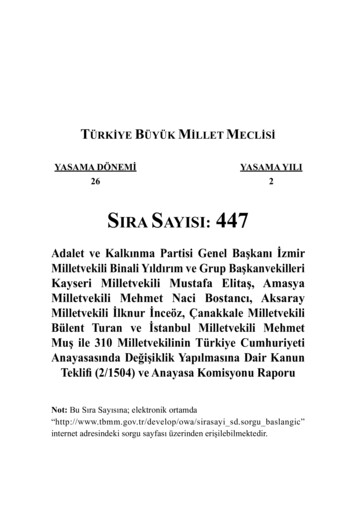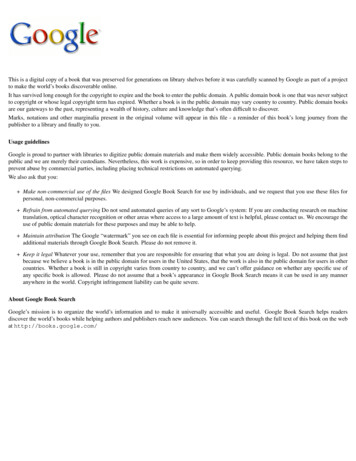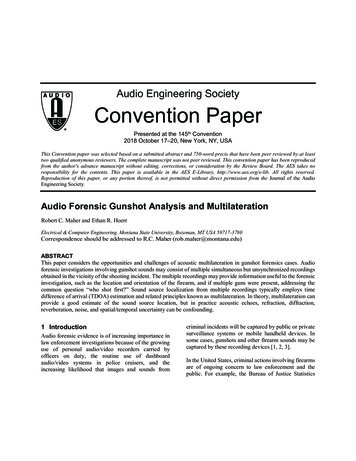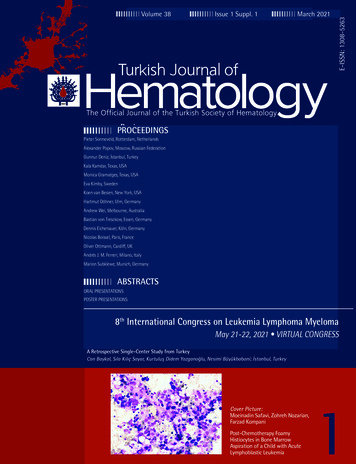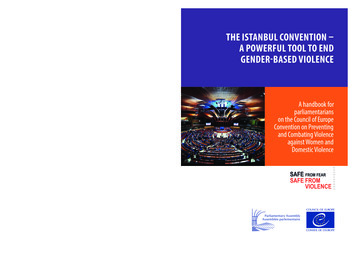
Transcription
THE ISTANBUL CONVENTION –A POWERFUL TOOL TO ENDGENDER-BASED VIOLENCEPREMS 010820Violence against women is a violation of humanrights and a form of discrimination against women.The Istanbul Convention aims to prevent violence,protect victims and prosecute perpetratorsthrough a comprehensive set of policies andmeasures. It aims to contribute to the eliminationof all forms of discrimination against women,promote substantive equality between womenand men and promote international co-operationwith a view to eliminating violence against womenand domestic violenceA handbook forparliamentarianson the Council of EuropeConvention on Preventingand Combating Violenceagainst Women andDomestic ViolenceENGwww.coe.intThe Council of Europe is the continent’s leadinghuman rights organisation. It comprises 47 memberstates, including all members of the EuropeanUnion. All Council of Europe member states havesigned up to the European Convention on HumanRights, a treaty designed to protect human rights,democracy and the rule of law. The European Courtof Human Rights oversees the implementationof the Convention in the member states.SAFE FROM FEARSAFE FROMVIOLENCE
THE ISTANBUL CONVENTION –A POWERFUL TOOL TO ENDGENDER-BASED VIOLENCEA handbook for parliamentarianson the Council of Europe Conventionon Preventing and Combating Violenceagainst Women and Domestic ViolenceCouncil of Europe
The opinions expressed in this work arethe responsibility of the author(s) anddo not necessarily reflect the officialpolicy of the Council of Europe.All requests concerning the reproductionor translation of all or part of the documentshould be addressed to the Directorate ofCommunications(F-67075 Strasbourg Cedex or publishing@coe.int). All other correspondence concerningthis publication should be addressed to theSecretariat of the Committee on Equalityand Non-Discrimination, ParliamentaryAssembly of the Council of Europe.Cover design and layout: Publications andDocuments Production Department (SPDP) Council of Europe, November 2019Printed at the Council of EuropeF-67075 Strasbourg CedexPrepared byThe Secretariat of the Committee onEquality and Non-Discriminationof the Parliamentary Assemblyof the Council of Europe in cooperationwith Anne-Katrin Speck, expert consultant
ContentsABBREVIATIONSGLOSSARY OF KEY TERMSCOUNCIL OF EUROPE: UPHOLDING WOMEN’S RIGHTS, STRIVING TOACHIEVE GENDER EQUALITY AND TO END VIOLENCE AGAINST WOMENAND DOMESTIC VIOLENCEThe Council of Europe in briefThe Parliamentary Assembly of the Council of Europe:combating violence against women4. HOW IS IMPLEMENTATION OF THE ISTANBUL CONVENTIONMONITORED?4.1. State reporting4.2. Urgent inquiry procedure4.3. General recommendations4.4. Monitoring the implementation of the Istanbul Convention:what role for parliaments?5. THE ROLE OF PARLIAMENTARIANS IN SUPPORTINGTHE ISTANBUL CONVENTION9991. WHY THIS HANDBOOK?2. THE SCOURGE OF VIOLENCE AGAINST WOMEN3. THE ISTANBUL CONVENTION:A COMPREHENSIVE LEGAL AND POLICY FRAMEWORK TO END GENDERBASED VIOLENCE3.1. Istanbul Convention: its purpose and scope3.2. Countering misinformation about the Istanbul Convention5711131516192121222223255.1. Promoting ratification of the Istanbul Convention265.2. Monitoring and supporting the implementation of the convention 285.3. Parliamentary engagement in GREVIO’s monitoring425.4. What structures and mechanisms are there for promotingimplementation?485.5. Summing up51 Page 3
6. IN-HOUSE EXPERTISE AND EXTERNAL ALLIANCES6.1. In-house expertise6.2. External alliances and expertise5353547. CONCLUSION55APPENDIX 1 – CHECKLIST FOR PARLIAMENTARIANS: HOW TO SUPPORTTHE ISTANBUL CONVENTION57APPENDIX 2 – TEXT OF THE ISTANBUL CONVENTION ON PREVENTINGAND COMBATING VIOLENCE AGAINST WOMEN AND DOMESTIC VIOLENCE(CETS NO. 210)65APPENDIX 3 – ADDITIONAL READING AND RESOURCES99Selected Council of Europe sourcesSelected international instrumentsOther useful links99104104
AbbreviationsCEDAWUN Convention on the Elimination of AllForms of Discrimination Against WomenCEDAW CommitteeUN Committee on the Elimination ofDiscrimination against WomenCETSCouncil of Europe Treaty SeriesCommittee of the PartiesCommittee of the Parties to the Councilof Europe Convention on Preventing andCombating Violence against Women andDomestic Violence (the Istanbul Convention)FGMFemale genital mutilationGREVIOGroup of Experts on Action against Violenceagainst Women and Domestic ViolenceHELPHuman Rights Education forLegal ProfessionalsIstanbul ConventionCouncil of Europe Convention onPreventing and Combating Violenceagainst Women and Domestic ViolenceNGONon-governmental organisationPACEParliamentary Assembly ofthe Council of Europe Page 5
Glossary of key termsViolence against women: all acts of gender-based violence that result in,or are likely to result in, physical, sexual, psychological or economic harmor suffering to women, including threats of such acts, coercion or arbitrarydeprivation of liberty, whether occurring in public or in private life.Domestic violence: all acts of physical, sexual, psychological or economicviolence that occur within the family or domestic unit or between formeror current spouses or partners, whether or not the perpetrator shares or hasshared the same residence with the victim.Gender: the socially constructed roles, behaviours, activities and attributesthat a given society considers appropriate for women and men. The IstanbulConvention recognises that gender stereotypes contribute to making violenceagainst women acceptable to some people.Gender-based violence against women: refers to violence directed againstwomen because they are women or violence that disproportionately affectswomen.Gender stereotyping: Gender stereotypes are preconceived ideas wherebymales and females are arbitrarily assigned characteristics and roles that aredetermined and limited by their sex. Page 7
Council of Europe:upholding women’srights, striving to achievegender equality and to endviolence against womenand domestic violenceThe Council of Europe in briefThe Council of Europe is the continent’s leading human rights organisation. Allthe 47 member states have signed up to the European Convention on HumanRights, a treaty designed to protect human rights, democracy and the rule oflaw. The Council of Europe has actively promoted the protection of womenand girls from gender-based violence. The adoption of the Convention onpreventing and combating violence against women and domestic violence(the “Istanbul Convention”) has firmly established the Council of Europe asa leading organisation in promoting gender equality, upholding women’shuman rights and ending gender-based violence.Did you know?The Istanbul Convention came into force in 2014, just over three years afterits adoption – a clear sign of European states’ commitment to the valuesand principles enshrined in the convention.The Parliamentary Assembly of the Council ofEurope: combating violence against womenThe Parliamentary Assembly brings together 648 members from the parliamentsof the Council of Europe’s 47 member states. It speaks on behalf of 830 millionEuropeans and represents the democratic conscience of the European continent. Page 9
The Assembly has consistently and forcefully condemned violence againstwomen as one of the most serious and pervasive violations of human rights. In2006, a group of dedicated parliamentarians set up the Parliamentary Network“Women Free from Violence”1 with the aim of actively engaging parliamentarians at all levels throughout Europe and beyond to raise awareness aboutthis serious violation of human rights, and to initiate, encourage and promotelegislative and policy changes to end gender-based violence.In 2008, the Assembly called for the adoption of legally binding European standards on violence against women2 – standards that were ultimately enshrinedin the Istanbul Convention. The Assembly was closely associated with negotiating and drafting the Istanbul Convention. This means that European citizens’democratically elected representatives were able to shape the content of themost progressive human rights treaty on ending violence against women.One major innovation of the Istanbul Convention is the involvement ofnational parliaments in the monitoring of implementation of the convention.Just as important, the Istanbul Convention includes a significant role for theParliamentary Assembly of the Council of Europe, which is invited to take stockof the implementation of the convention at regular intervals.1.2.Want to know who represents your parliament in the network “Women free from violence”?The list of members is available online, at http://www.assembly.coe.int/nw/Page-EN.asp?LID WFfV (accessed 22 Oct 2019).See PACE Resolution 1635 (2008) and Recommendation 1847 (2008) on Combating violenceagainst women: towards a Council of Europe convention.Page 10 The Istanbul Convention – A powerful tool to end gender-based violence
1. Why this handbook?The Council of Europe Istanbul Convention is the most progressive andambitious international human rights treaty targeting the eliminationof violence against women. It has received two prestigious internationalprizes3 and is often referred to as a “gold standard”4 in the fight against genderbased violence.Since its adoption in April 2011, the convention has had significant positiveimpact across Europe. It has contributed to garnering public attention to theurgent need to take action to combat violence against women and domesticviolence. The convention has triggered and inspired important progressivechanges to domestic laws and policies related to gender-based violence. Ithas highlighted the need for more shelters and services for women who arevictims of violence. Furthermore, the convention has generated much-neededpublic debates around issues related to sexual violence, in particular rape.Yet even the most powerful standards can only lead to long-lasting positivechange if countries sign, ratify and fully implement the convention. In thisregard, parliaments and parliamentarians play an instrumental role. They canlend democratic legitimacy to measures aimed at giving effect to the treaty,create robust legal and policy frameworks aimed at ending violence againstwomen and monitor their effective implementation. Their important role inapproving national budgets and providing oversight of executive action positions the legislature as a key stakeholder in the fight against gender-basedviolence.3.4.In 2012, the Spanish Observatory against domestic and gender violence presented theCouncil of Europe with its most prominent Recognition Award on the eradication of gender-based violence for the drafting of the Istanbul Convention. In 2015, the conventionwas honoured with the prestigious Vision Award by the World Future Council, the InterParliamentary Union and UN Women, in recognition of its contribution to the fight againstviolence against women.Remarks by Lakshmi Puri, former Deputy Executive Director of UN Women, on the occasionof the Council of Europe side event “Violence against women – our concern, our response”at the 57th Session of the Commission on the Status of Women; New York, 4 March 2013,available at: lakshmi-puri-atcsw57-side-event (accessed 22 Oct 2019). Page 11
This handbook aspires to be a practical resource for parliamentarians acrossthe political spectrum and from all political systems, regardless of whethertheir country has already ratified or is yet to ratify the Istanbul Convention. Itaims to strengthen parliamentary knowledge about the convention and tosupport parliamentarians across Europe to play an active role in promotingits ratification and implementation. It also presents examples5 of how parliamentarians can use their legislative, oversight and other functions to help endviolence against women and domestic violence.5.This handbook draws on interviews with members of the Parliamentary Assembly as wellas responses to a questionnaire circulated to national parliamentary delegations in March2019 via the European Centre for Parliamentary Research and Documentation (ECPRD),available on the website of the Assembly’s Committee on Equality and Non-Discrimination,at lence/IstanbulQuestionnaire-EN.pdf.Page 12 The Istanbul Convention – A powerful tool to end gender-based violence
2. The scourge of violenceagainst womenViolence against women and domestic violence continues to be oneof the most pervasive human rights violations worldwide. It affectswomen from all walks of life, irrespective of cultural, religious, economic,social or geographical backgrounds. Global estimates from the World HealthOrganization suggest that one in three women worldwide will experiencegender-based violence in their lifetime.6Europe is no exception. Every day, women across our continent are psychologically and physically abused, harassed, stalked, raped, mutilated, forced by theirfamily to enter into marriage or sterilised against their will. A survey carried outby the European Union Agency for Fundamental Rights showed that between45% and 55% of women and girls from the age of 15 in the European Unionhave been victims of sexual harassment.7 National surveys also reveal thatdomestic, sexual and other forms of violence against women are widespread.Gender-based violence has devastating consequences for the victims andfor society as a whole. Recognising the scope and impact of this scourge isindispensable if we are to make the struggle to end violence against womenand domestic violence effective.6.7.For estimates, see against-women(accessed 22 Oct 2019).The survey results are available at st-women-survey (accessed 22 Oct 2019). Page 13
3. The Istanbul Convention:a comprehensive legal andpolicy framework to endgender-based violenceThe Istanbul Convention8 is a ground-breaking, legally binding international treaty to eradicate violence against women and domestic violence. The convention provides those states that have ratified it with acomprehensive framework of policies and measures based on best practice,to prevent and combat violence against women and domestic violence. Theconvention was created in Europe but it has global outreach. It is drafted withthe understanding that measures to address the global problems related togender-based violence should not be limited to a particular geographic area.Any state can accede to it or use it as a blueprint for national and regionallegislation and policies.The strength of the convention lies in its comprehensiveness and its commitment to tackling the root causes of violence against women and domestic violence. This section sets out the key principles of the convention anddemonstrates its potential to bring us closer to creating societies free fromgender-based violence.The Istanbul Convention is a manifesto, laying down a vision of societyin which women are not subordinated to men and gender equality is fullyachieved.98.9.As of 30 June 2019, 34 states have ratified the convention; 11 member states and the EuropeanUnion have signed the convention. Not sure if your country has signed and ratified theIstanbul Convention? Consult the chart of signatures and ratifications at ions/treaty/210/signatures (accessed 22 Oct 2019).The Istanbul Convention on violence against women: achievements and challenges”, PACEReport, 8 June 2019, Doc. 14908, §12). Page 15
3.1. Istanbul Convention: its purpose and scopeThe purpose of the convention is to end violence against women and domesticviolence and to safeguard the fundamental human right for women to live alife free from violence. The scope of the convention covers all forms of violenceagainst women, including domestic violence, which affects women disproportionately. The cornerstones of the Istanbul Convention are the prevention ofviolence, the protection of victims and the prosecution of the perpetrators. Theconvention acknowledges that the struggle against gender-based violence canonly ever be effective if states implement holistic and co-ordinated policies.The Istanbul Convention’s 4 Ps approach Prevention Protection Prosecution Integrated Policies3.1.1. Whom does the convention protect?The main beneficiaries of the Istanbul Convention are women. The reasonfor this is simple: the convention seeks to tackle forms of violence that areexperienced only by women because they are women (such as female genitalmutilation or forced abortion) or that women are disproportionately exposedto in comparison with men (domestic violence, forced marriage, forced sterilisation, rape and other forms of sexual violence, sexual harassment or stalking).Parties to the Istanbul Convention are encouraged to extend its application toeveryone at risk of or affected by domestic violence, including male, child andelderly victims. This is in recognition of the fact that men also experience someforms of violence covered by the Istanbul Convention, albeit less frequentlyand often in less severe forms.3.1.2. What does the convention require states to do?Human rights are often framed in terms of behaviour that states must refrainfrom: state officials must not torture or discriminate against individuals, norrestrict their right to freedom of expression without justification. Similarly,state authorities and others acting on behalf of the state must refrain fromacts of violence against women. But states have positive obligations, too. Thisdimension of their international obligations is particularly important in thePage 16 The Istanbul Convention – A powerful tool to end gender-based violence
context of violence against women and domestic violence, which is moreoften perpetrated by private individuals than by state agents. Accordingly,the Istanbul Convention includes and integrates the “due diligence” standard,defined as the states’ obligation to “prevent, investigate, punish and providereparation for acts of violence perpetrated by non-state actors” (Article 5).Furthermore, it is crucial to recognise that violence against women anddomestic violence do not occur in a vacuum. They thrive in societies whereharmful attitudes, prejudices, gender stereotypes and gender-biased customsor traditions condone or encourage behaviour that puts women down andtreats them as inferior. This is the breeding ground for violence against women,including domestic violence. The Istanbul Convention therefore requiresstates to adopt a series of measures to be implemented with a view to preventviolence, protect victims and prosecute perpetrators through co-ordinatedmeasures and policies.PreventionThe convention contains the general obligation to prevent violence againstwomen and detailed preventive measures which aim to: promotechanges in attitudes and behaviour that condone violenceagainst women; raise awareness to enable the public to recognise gender-based violencein all its forms, wherever it occurs, and to speak out against it; include teaching material on equality issues in the curricula at all levelsof education, in order to teach children mutual respect in relationships; trainall relevant professionals working with victims in the preventionand detection of violence; develop treatment programmes for perpetrators of domestic violenceand sex offenders, aimed at teaching them to respect women and adoptnon-violent behaviour.ProtectionEffectively protecting women from gender-based violence requires the adoption of a series of measures aimed at supporting those at risk of violence. Forthis purpose, the convention provides that states shall: place the needs and safety of victims at the heart of all measures; ensurethat survivors know where and how to get help, and set upspecialised support services that provide them with medical assistanceas well as psychological and legal counselling;a comprehensive legal and policy framework to end gender-based violence Page 17
provide shelters and 24/7 telephone helplines; establishemergency barring orders to remove perpetrators from thefamily home, as well as restraint or protection orders; protect and support children who witness violence within their families.ProsecutionA strong criminal law framework is needed to bring justice to victims, holdperpetrators accountable and end impunity: under the Istanbul Convention,states parties are expected to criminalise (or penalise through other measures)the various forms of violence, including: psychological violence; stalking; sexual violence, including rape; sexual harassment; forced marriage; female genital mutilation; forced abortion and forced sterilisation.States parties are also required to: ensure that all these forms of violence are appropriately punished; ensurethat culture, religion, tradition or other personal reasons arenot accepted as a defence for criminal behaviour, neither in law nor inpractice; ensure that victims and their children have access to special protectionmeasures during investigation and judicial proceedings; ensure that law-enforcement agencies respond immediately to callsfor assistance, manage dangerous situations adequately and swiftlyinvestigate all allegations of violence against women.Integrated policiesViolence against women and domestic violence cannot effectively be tackledby uncoordinated, haphazard responses. Eradicating the root causes and symptoms of gender-based and domestic violence requires concerted efforts by avariety of actors, including the police, judiciary, social services, child protectionagencies, health care professionals, women’s non-governmental organisationsand other relevant partners. The Istanbul Convention recognises this need, andcalls for a holistic response to violence through integrated, comprehensiveand co-ordinated policies that put the needs of victims at the centre.Page 18 The Istanbul Convention – A powerful tool to end gender-based violence
Five years after its entry into force, the Assembly believes that the IstanbulConvention has already had a tangible and positive impact. It has contributed to raising victims’ awareness and to raising awareness in society ingeneral . Discussions on the possible ratification have led to debateson violence against women, its extent and impact on victims and on theurgency of combating it to save lives.103.2. Countering misinformation aboutthe Istanbul ConventionAll actions required by the Istanbul Convention are geared towards the aimof ending violence against women, an objective that we should all be ableto agree on. Yet the past few years have seen, across and beyond Europe, abacklash against women’s human rights. Perhaps unsurprisingly, this backlashhas left its mark on the Istanbul Convention, slowing down the progress ofits wide ratification and implementation. Such developments require boththe attention of and action by parliamentarians. They constitute an attackon the progressive normative framework established by European nationswhich collectively negotiated, drafted and unanimously adopted the IstanbulConvention, with important input from democratically elected parliamentarians.3.2.1. What can you do to counter attacks and addressmisconceptions about the Istanbul Convention?Know who is behind these attacks: a rather “unholy alliance” of religious, ultraconservative groups and self-proclaimed “men’s rights activists” that have beenspreading false narratives about the Istanbul Convention. They take issue withrights and concepts that have long been recognised in international humanrights law. Their intent is to undermine the very objective that the IstanbulConvention seeks to achieve: eradicating inequality between women andmen, which is the breeding ground for gender-based violence.Speak out against misinformation, because remaining silent while othersspread falsehoods about the Istanbul Convention would mean surrenderingthe important gains that the convention has brought in terms of the protection of women’s human rights.Stress the facts: your public support for the convention is crucial to ensureits maximum impact. Use social and traditional media, interviews and other10. “The Istanbul Convention on violence against women: achievements and challenges”,PACE Report, 8 June 2019, Doc. 14908, §8.a comprehensive legal and policy framework to end gender-based violence Page 19
means to emphasise the aims of the Istanbul Convention: protecting womenfrom gender-based violence. Highlight the convention’s key benefits andachievements.Need more information?The Council of Europe has produced guidance in the form of a handyQuestion-and-Answer brochure aimed at exposing and rectifying misconceptions about the Istanbul Convention. All parliamentarians are invited touse this brochure, available in 20 languages, when engaging in discussionsor debate on the real aims of the Istanbul Convention.1111. The Question-and-Answer brochure is available at uestions-istanbul-conventionweb-16x16/16808f0b80 (accessed 22 Oct2019).Page 20 The Istanbul Convention – A powerful tool to end gender-based violence
4. How is implementationof the Istanbul Conventionmonitored?The convention sets up a monitoring mechanism to assess how well itsprovisions are put into practice. This mechanism consists of two distinct,but interacting pillars: the Group of Experts on Action against Violenceagainst Women and Domestic Violence (GREVIO), an independent expertbody, and the Committee of the Parties, a political body composed of officialrepresentatives of the states that are party to the convention. Their findingsand recommendations help ensure states’ compliance with the conventionand guarantee its long-term effectiveness.4.1. State reportingAt the core of the supervisory mechanism established under the IstanbulConvention is a country-by-country evaluation procedure carried out byGREVIO on the basis of state reports and additional information gathering.12Figure 1 shows the workflow of GREVIO’s ongoing first (baseline) evaluation.State parties are expected to use GREVIO’s questionnaire13 to report on legislative and other measures giving effect to all the provisions of the IstanbulConvention. Based on the information obtained from the state and throughshadow reports by non-governmental organisations (NGOs) or national humanrights institutions, GREVIO makes a comprehensive assessment of the statusof implementation of the convention. As illustrated by the flowchart in Figure1, the monitoring process is based on dialogue between the supervisory bodyand a wide range of domestic interlocutors.12. More information on GREVIO’s monitoring and its first (baseline) evaluation round isavailable at: oring1 and e-first-baseline-evaluation-procedure (bothaccessed 23 Oct 2019).13. The GREVIO questionnaire (accessed 23 Oct 2019) is available at: / DisplayDCTMContent?documentId 09000016805c95b0. Page 21
Figure 1 – Workflow of GREVIO’s first (baseline) evaluation procedure. Istanbul Convention website.ISTANBUL CONVENTIONGREVIO’s First (Baseline) Evaluation ProcedureQ* State ReportAdditional InformationàEvaluation visitDRAFTGREVIOREPORTNGOsNational HR InstitutionsOther CoE BodiesOther Treaty BodiesGovernmentCommentsGREVIO REPORTCommittee of the PartiesPublicationState PartyàAdoptionwith GovernmentComments* GREVIO’s Questionnaire sent to State PartiesParliament(s)IC/Inf(2016)3rev 19/09/20194.2. Urgent inquiry procedureThe Istanbul Convention also provides for a special urgent inquiry procedure14which allows for urgent action to be taken “to prevent a serious, massive orpersistent pattern of any of the acts of violence covered by the convention.”15Where GREVIO concludes that a situation requires immediate attention, it maytrigger the inquiry procedure and request the urgent submission of a specialreport by the state concerned.4.3. General recommendationsFinally, GREVIO may adopt recommendations that are not specific to anycountry, but that deal with issues of concern to all state parties. This procedure14. More information is available at: /DisplayDCTMContent?documentId 0900001680462547 (accessed 23 Oct 2019).15. Paragraph 358 of the explanatory report to the Istanbul Convention, available at: /conventions/treaty/210 (accessed 23 Oct2019).Page 22 The Istanbul Convention – A powerful tool to end gender-based violence
offers a way for GREVIO to produce guidance on the effective implementationof the provisions in the convention, by clarifying key themes and concepts.4.4. Monitoring the implementation of the IstanbulConvention: what role for parliaments?The Istanbul Convention is a landmark instrument in terms of its content. Butit is also innovative in explicitly envisaging in Article 70 a role for parliamentsin monitoring its implementation.Article 701. National parliaments shall be invited to participate in the monitoring ofthe measures taken for the implementation of this Convention.2. Parties shall submit the reports of GREVIO to their national parliaments.3. The Parliamentary Assembly of the Council of Europe shall be invited toregularly take stock of the implementation of this Convention.The Istanbul Convention is the only international human rights instrumentto expressly recognise the importance of involving national parliaments inassessing the implementation of the treaty. Governments are required toinvite national parliaments to participate in the monitoring. They must alsosubmit t
democracy and the rule of law. The European Court of Human Rights oversees the implementation of the Convention in the member states. www.coe.int Violence against women is a violation of human rights and a form of discrimination against women. The Istanbul Convention aims to prevent violence, protect victims and prosecute perpetrators



